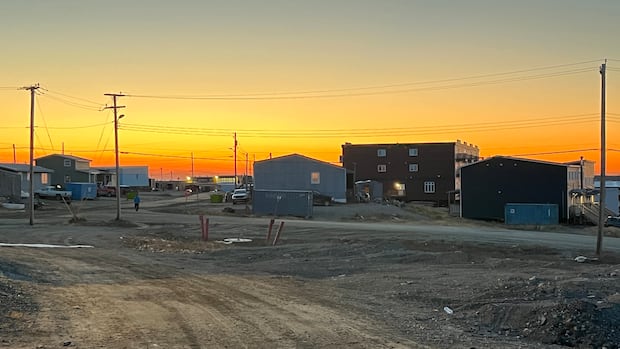When Prime Minister Mark Carney releases his second list of nation-building projects — expected sometime in the next month — Anne-Raphaëlle Audouin hopes the Kivalliq Hydro-Fibre Link will be on it.”It’s the very definition of nation building because it fills a very critical infrastructure gap,” said Audouin, CEO of Nukik, an Inuit-owned company focused on major infrastructure projects such as the hydro-fibre link.It “can power communities, can power future mining development and certainly can power defence as well.”The proposed $3.3-billion, 1,200-kilometre, 150-megawatt transmission line with fibre-optic cable would connect Manitoba’s hydro grid to five communities and at least one gold mine in the Kivalliq region of Nunavut.The Nukik website says the transition to clean energy would improve local air quality, reduce greenhouse gas emissions by 371,000 metric tons annually and displace 138 million litres of fuel per year.It would significantly reduce the risk associated with shipping heavy fuels across Arctic waters and of spills in communities.Nunavut imports all of its fuel during the summer months and stores it to power local diesel generators, the main electricity source for isolated communities. There is no shared transmission grid; each community has its own power plant.Nearly all of the internet that serves governments, businesses, schools and residents is powered by Starlink, Audouin said.Anne-Raphaëlle Audouin, CEO of Nukik, an Inuit-owned company focused on major infrastructure projects like the Kivalliq Hydro-Fibre Link, describes the project as ‘transformational.’ (Submitted by Nukik Corp.)”So if the U.S. decides to turn their back on Canada — and maybe a few years ago, that wasn’t a real statement to make, but now it is very much a tangible risk — if our relationship with the U.S. gets to a point where they just abandon those pathways of serving Nunavut with those products and communities, then Nunavut goes dark.”Nukik hopes to have shovels in the ground by 2028, getting power to the mine by 2032.The project would create jobs and generate approximately $8 billion in revenue over 50 years, she said.In April, Manitoba Premier Wab Kinew and Nunavut Premier P.J. Akeeagok signed an agreement to work together on the project and ask Ottawa for capital funding.There is an existing transmission line to Churchill, Man., but it needs upgrading. There is no Manitoba Hydro infrastructure beyond that.The project would use the Port of Churchill as a supply route, strengthening the Churchill Plus proposal as another potential nation-building project.Expanding Churchill’s 100-year-old deepwater port is high on Prime Minister Mark Carney’s nation-building agenda It’s mentioned in Manitoba’s recently announced Path to Net Zero as a way of helping remote northern communities reduce their reliance on diesel and fossil fuels and transition to renewable energy.The Nukik website says the transition to clean energy would improve local air quality, reduce greenhouse gas emissions and displace 138 million litres of fuel per year. (Jaison Empson/CBC)Those synergies appeal to Rebecca Chartrand, the federal minister of northern and Arctic affairs and MP for Churchill-Keewatinook Aski.”If we focus specifically on the core infrastructure of Churchill, there will be the opportunity to unlock other projects, such as the Kivalliq hydro line from Manitoba to Iqaluit, or the Minago [nickel] mine, for example, which is 100 per cent Indigenous-owned mine in Manitoba,” she said in an interview with CBC News. Feds to advise project to bring hydroelectricity to Nunavut from Manitoba How one major project is vying to be fast-tracked by the federal government Educating communities along the proposed lineDuring a recent community engagement meeting in Churchill, Kono Tattuinee, president of the Kivalliq Inuit Association and a Nukik board member, explained the project and answered questions. Joe Stover wanted to know whethera new hydro line could go through Churchill instead of 50 km southwest under the current plan. ‘A new line that would be coming pretty close to Churchill — like having a spur to come here to give us more hydro security and power security — I think that would be a good thing,” Stover said.Tattuinee agreed, saying the line could support both regions. During a recent community engagement meeting in Churchill, Kono Tattuinee, president of the Kivalliq Inuit Association and a Nukik board member, explained the project and answered questions. (Karen Pauls/CBC)“The last nation building that was up in this part of the world was in 1929, when the railroad stopped here,” Tattuinee said.An important piece of the hydro-fibre link is Inuit leadership in addressing Nunavut’s infrastructure gap, he said.“It’s just going to open the door for so many opportunities out there, i.e. for health care, i.e. for education, and there’s so many ways that we can access the connectivity and obviously the hydro, which would put the cost down substantially.”After talking with Tattuinee, Stover said he doesn’t see any downsides to the hydro-fibre line. “The port, I would imagine, would be getting more use, the rail line would be getting use, and certainly, the busier any of those things are, the more employment there is. And if there’s more employment, then obviously the community is stronger,” he said.”So yeah, I think it would be something that Churchill would support.”Support, but some concernsThe project is also getting support from businesses such as the North West Company.In a statement, communications director Brigitte Burgoyne said the company wants to see more public investments in public infrastructure “to enhance supply chains, mobility, and opportunities for northerners.””High energy costs have a compounding effect on affordability in the North, driving up the cost of goods and essential services. Projects like the Kivalliq Hydro-Fibre Link can help lower these costs,” Burgoyne wrote.Harry Towtongie, mayor of Rankin Inlet, says the proposed hydro-fibre link will lower prices on electricity but he worries about impacts on the wildlife. (Matisse Harvey/CBC )The mayor of Rankin Inlet sees the benefits. Harry Towtongie is also a local businessman. He says the cost of electricity is more than three times higher in his community than in Churchill.“The cost of everything is high, but this is one of the bigger expenses that we have up North. [It would be a] big deal to have reliable, cheaper power source,” he said.Still, Towtongie has questions. Where exactly will the transmission lines be built? Will locals get any of the jobs? And how will it impact the environment and the wildlife?The mayor of Rankin Inlet is among those wondering how the proposed hydro-fibre link will impact wildlife like caribou. (Noel Kaludjak/CBC)“There’s other animals besides caribou. There’s polar bears, there is fishing, there are a lot of issues with wildlife,” he said. “We don’t want to affect them.”Audouin and Tattuinee acknowledge it’s a tough balance, but they say environmental issues are being studied, and they can be managed.Meanwhile, Audouin points out that countries including Russia, Finland, Sweden and Norway built transmission lines and roads past the Arctic Circle decades ago, and it’s time Canada does the same.”You’re not going to build the Kivalliq Hydro-Fibre Link and then in 30-40 years say, ‘Oh my gosh, I regret connecting the Nunavut Arctic to the rest of Canada.’ It’s just something that is so transformational,” she said.“We need to signal to international players that Canada is serious about the Canadian Arctic, and you cannot have a strong Arctic without strong communities, and you cannot have strong communities without basic infrastructure.”Nunavut Tunngavik, Nunavut gov’t outline priorities for Arctic security and sovereigntyAs China explores the Arctic, Canada’s military is preparing for confrontationNukik is looking for private and federal support to complete their last year of development and start licensing and the permitting process, and then get into the detailed engineering phase of the project.The federal government has already spent more than $14 million on planning and feasibility studies.WATCH | Kivalliq Hydro-Fibre Link pitched as nation-building project:Nunavut pitches Kivalliq Hydro-Fibre Link as nation-building projectManitoba and Nunavut have already signed an agreement to work together on the proposed $3.3-billion, 1,200-kilometre, 150-megawatt transmission line with fibre-optic cable, which would connect Manitoba’s hydro grid to five communities and at least one gold mine in the Kivalliq region of Nunavut.
Tuesday, 25 Nov 2025
Canada – The Illusion
Search
Have an existing account?
Sign In
© 2022 Foxiz News Network. Ruby Design Company. All Rights Reserved.
You May also Like
- More News:
- history
- Standing Bear Network
- John Gonzalez
- ᐊᔭᐦᑊ ayahp — It happened
- Creation
- Beneath the Water
- Olympic gold medal
- Jim Thorpe
- type O blood
- the bringer of life
- Raven
- Wás’agi
- NoiseCat
- 'Sugarcane'
- The rivers still sing
- ᑲᓂᐸᐏᐟ ᒪᐢᑿ
- ᐅᑳᐤ okâw — We remember
- ᐊᓂᓈᐯᐃᐧᐣ aninâpêwin — Truth
- This is what it means to be human.
- Nokoma












